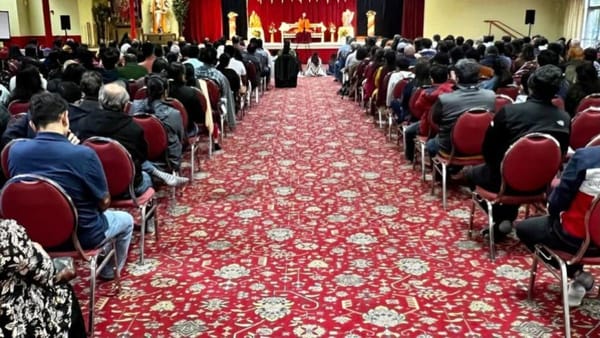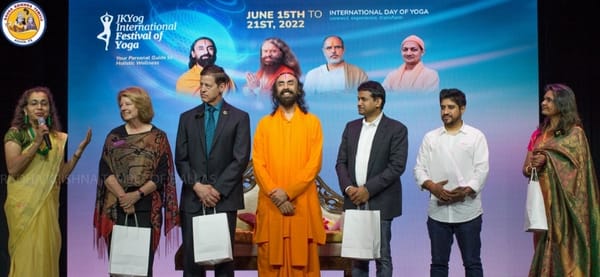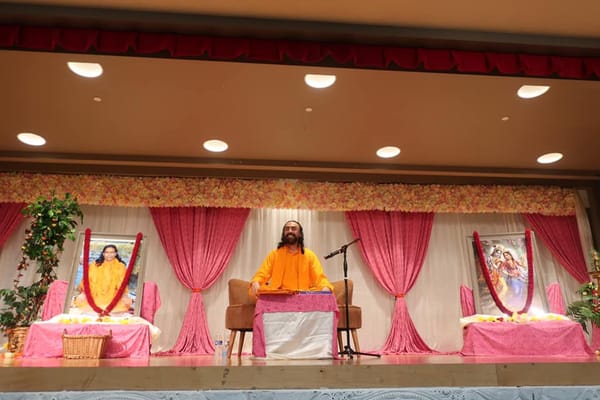Hasyasans (Laughter Yoga Poses)
Hasyasan or popularly known as laughter yoga pose is formed by the two words “Hasya” meaning “to laugh” and “asan” meaning “a pose.”
The integrated sense of it is to laugh in different poses. JKYog system of yoga teaches you five types of Hasyasans that will free you from your anxieties, stress, and tensions.
1. Ucha-Attahas Hasyasan [Booming Laughter Yoga Pose]
First pose under JKYog Hasyasan in the Ucha-Attahas Hasyasan or the Booming Laughter Yoga Pose. Here Swami Mukundananda, a world-renowned teacher of Yoga, Meditation and Spirituality is showing us the technique of booming laughter yoga pose.
Procedure
i. Sit in Sukhasan.
ii. Raise your hands up and laugh boomingly.
Second pose under JKYog Hasyasan in the Gur-Gur Hasyasan or the Chuckle Laughter Yoga Pose. This is, basically, a laughter Yoga pose where you laugh with your mouth close.
2. Gur-Gur Hasysan [Chuckle Laughter Yoga Pose]
Second pose under JKYog Hasyasan in the Gur-Gur Hasyasan or the Chuckle Laughter Yoga Pose. This is, basically, a laughter Yoga pose where you laugh with your mouth close.
Procedure
i. Sit in Sukhasan.
ii. Laugh or chuckle with your mouth shut.
3. Dandiya Hasyasan [Stick Dance Laughter Yoga Pose]
Third pose under JKYog Hasyasan is the Dandiya Hasyasan. Dandiya is a traditional Gujarati (Indian) dance where a couple dances with a pair of stick in their hand. In this pose, you will imagine that you are dancing with sticks and move your hand either sides, clap and laugh.
Procedure
i. Sit in Sukhasan.
ii. Tilt either ways, clap your hands, and laugh loudly.
4. Anaram Hasyasan [Vowel Laughter Yoga Pose]
Forth pose under JKYog Hasyasan is the Anaram Hasyasan. Anaram is vowels of Devnagari script. They are pronounced as a, aa, i, ee, u, oo, e, ai, o, au, ri. In this laughter yoga pose, you will laugh and enunciate these vowels. You can use vowels of any other script.
Procedure
i. Sit in Sukhasan.
ii. Raise your hands one by one and laugh enunciating the swar varṇa (vowels) of the Devanāgarī script.
iii. You could also use vowels from the English script—“a, e, i, o, u.”
5. Gud-Gud Hasyasan [Tickle Laughter Yoga Pose]
Fifth pose under JKYog Hasyasan is the Gud-Gud Hasyasan or tickle your partner laughter yoga pose. This is most popular laughing yoga pose. Here you get to tickle your partner and your partner, in return, tickles you back.
Procedure
i. Get another person to pair with you, and sit in Sukhasan facing each other.
ii. Tickle each other and laugh.
Benefits of Hasyasan or Laughter Yoga
- Hasyasans make your heart very healthy.
- They activate about 75 muscles in different parts of your body, thus resulting in the increase of blood level throughout the whole body.
- They release mental and emotional strains and help inducing zeal and vigor.
- You feel extremely released, vibrant, and fresh upon practicing the above mentioned of Laughter Poses.
- They strengthen your immune system.
- It helps growing the intellectual performance and boosting information retention.
- Laughter poses significantly help control diabetes by reducing blood sugar levels thus.
- These asans are cathartic exercises, which assist the practitioners in venting out their condensed emotions in systematic and organized way. Thus, they help develop positive emotions and reduce the negative ones, thereby ensuring a healthy life.
- According to Dr. Otto Warburg, a German scientist and Nobel Laureate, the main cause of our illness is due to the deficiency of oxygen in our body cells. Laughter poses bringadequate oxygen to both—the body and brain; adequate supply of oxygen is the basic factor for keeping a sound health. Thus, these Yogic exercises are equally significant for people suffering from cancer and different chronic respiratory diseases like bronchitis and so on.
- Everybody knows that immune system plays a crucial role in the causation and prognosis of cancer; the most probable trigger for the occurrence of cancer is the weak immune system of a person. Laughter poses increase the number of natural killer cells—the main factors of the immune system; thus these Yogic asans assist in both—overcoming andterminating cancer cells.
Contraindications People with the problems like depression, high blood pressure, and heart ailments; and also those who have undergone recent surgical operations of abdominal parts should not attempt any of these Hasyasans.







